![]()
AirWest
TIMETABLES
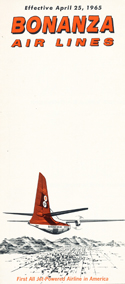 April
1965
April
1965
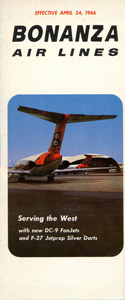 April
1966
April
1966
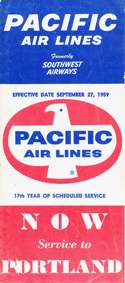 September 1959
September 1959
 January
1968
January
1968
.jpg) April
1968
April
1968
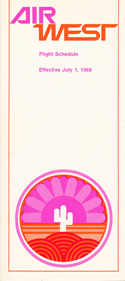 April
1968
April
1968
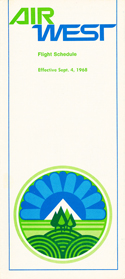 September
1968
September
1968
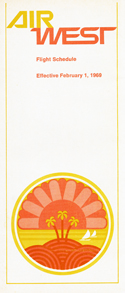 February
1969
February
1969
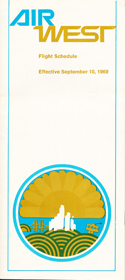 September
1969
September
1969
AirWest (RW) was the result of a merger between three local service airlines; Bonanza Air Lines, Pacific Air Lines, and West Coast Airlines in 1968.
Bonanza Air Lines: Bonanza started operations in 1945, as a charter operator based in Las Vegas, Nevada. Realizing the potential of air service over the rather rural and desolate route between Las Vegas and Reno, Nevada the airline became certified as a "local service" carrier in 1949. With routes extending into Southern California and Arizona the airline placed the Fairchild F-27 turboprop in service during 1959. Once the F-27s replaced the Douglas DC-3s during late 1960, Bonanza touted itself as an "all turbine" fleet, becoming the first airline in the U.S. to do so. Looking to join the "jet" side of operations, the airline originally placed an order for the British Aerospace BAC-1-11 twin-jet, however this order was blocked by regulatory agencies. Instead Bonanza placed an order of the Douglas DC-9, starting service with the plane in March 1966, and becoming the first "local" airline to place the DC-9 into service. By 1968, Bonanza had become a large regional airline serving twenty-two cities, from Reno, Nevada to the north, Puerto Vallarta, Mexico in the south, and east to Tucson, Arizona with a fleet of both Fairchild F-27 and Douglas DC-9 aircraft.
Pacific Air Lines: Predecessor Southwest Airways was formed in 1941, as a flight school in Arizona and evolved to start passenger flights within California in December 1946. By 1950, Southwest was operating a fleet of ten Douglas DC-3s and serving twenty-four towns and cities in both California and Oregon. The airline continued to grow and retitled itself Pacific Air Lines based at San Francisco, California. Like other neighboring "locals", Pacific was looking to increase passenger comfort and speed on routes and ordered six Fairchild F-27 turboprops. The first plane was delivered in 1959, and used on the more heavily traveled routes between Los Angeles and San Francisco. Seeking to add jet service to its routes, the airline ordered six Boeing 737, but instead took delivery of three 727s before the merger resulting in the 737s not taken up.
West Coast Airlines: Tracing its roots back to Zimmerly Airlines in Lewiston, Idaho in 1939, becoming one of the largest of the local service airlines in the Pacific Northwest. When West Coast Airlines was established in 1946 (after a name change), it was granted one of the first regional airline certificates by the Civil Aeronautics Board (CAB). During this time a small fleet of war-surplus Douglas C-47 (DC-3) aircraft provided service from a Seattle, Washington base (Boeing Field) to points in both Oregon and Washington. In 1953, Idaho based Empire Airlines was merged into West Coast adding additional cities and routes to the growing airlines. Faced with the sometimes difficult task of flying along the rugged Cascade Range, the airline sought a more robust and efficient aircraft. The Fairchild F-27 was the answer with it's turboprop engines and high-wing design, West Coast became the first airline world-wide to place the F-27 in passenger service in 1958. The airline continued to grow eventually placing the Douglas DC-9 into service in 1966, and extending services into California. By 1968, the airline was flying to six western states as well as Alberta, Canada with a fleet of Douglas DC-3s, DC-9s and Fairchild F-27s.
With three local service airlines now serving a wide range of the West Coast region of the United States, it was noticed that although each carrier had similar equipment, the various routes each were flying rarely overlapped yet services met at the major airports. Competition from both major carriers as well as intra-state airlines such as Pacific Southwest Airlines (PSA) were starting to effect the locals, on their major city pair routes. Some thoughts of a merger were discussed as early as 1967, as a way to "band" together and stave off emerging competition and make overall operations more economical. After numerous discussions it was determined the only way for the local carriers to survive the future was to merge together to form one airline. On April 17, 1968 the CAB approved the merge of Bonanza Air Lines, Pacific Air Lines, and West Coast Airlines to form a new carrier appropriately called AirWest. The three airlines were officially merged under the AirWest title on July 1, 1968. The new airline would have its corporate offices located in the old Pacific Air Lines facilities at San Francisco, while the major maintenance would be handled at the old Bonanza facilities in Phoenix, Arizona.
A new rebranding of the airline took place, including the introduction of a new color scheme consisting of a bold, two-tone colored tail along with two-toned modern script on a white fuselage. The series of "Fiesta" colors were based upon the airlines varied destinations across its now extensive western territory. Four colors were applied; Sky blue/Orche representing the contrasting colors of the sky and hills of the San Francisco Bay area, Orche/Rust Orange representing the rich colors of the upper Mexican coastal landscape, Fuchsia/Rust Orange representing the striking desert southwest, and Blue/Lime Green representing the environs of the Pacific Northwest. The colors were simple yet dramatic in establishing AirWest's new combined operating profile across the West. The one benefit of the merger was the fleet commonality the locals had shared which made the transition much easier. The Douglas DC-9s would continue to be used on trunk routes throughout the system while the smaller F-27s were used on lighter, thinner routes to smaller communities. West Coast had been using a few Piper Navajo's and Pacific had the larger 727s which did not fit well into the AirWest plans, so both planes were either disposed of or leased to other carriers (727s).
A few months after the merger AirWest had become a large, regional airline flying to over eighty cities in the west from Calgary, Canada in the north, south to Puerto Vallarta, Mexico and east to Great Falls, Montana. There was even proposals to extended services further east to Albuquerque, New Mexico, Dallas Ft-Worth, Texas and south to Mexico City and Acapulco, Mexico, however the future was looking bleak. The combined operations of the three carriers together as one quickly took a toll on financial resources.
After the official merger date of the new
AirWest on July 1, 1968, rumors were abound that just a month later,
Chairman of AirWest Nick Bez was in closed door negotiations with the
reclusive, billionaire Howard Hughes for a purchase of the airline.
Howard Hughes famous for his aviation pursuits and shrewd business
dealings was no stranger to the airline business having at one point
acquired 78% of Trans World Airline (TWA) stock in 1939 and helping the
airline expand and introduce new aircraft. Hughes essentially maintained
control of TWA through 1966, when management battles, poor financial
decisions and conflict of interested resulting in his sale of stock.
Howard Hughes relocated to Las Vegas, Nevada in 1966 and took ownership
of many businesses including aviation related enterprises at Las
Vegas-McCarran Airport. During this time in 1966, Bonanza Air Lines was
based at Las Vegas and after the AirWest merger in in July 1968, Hughes
became interested in the prospect of owning another airline. Although it
had just been a month since the merger, AirWest was already facing
difficulties with a slower economy and additional lease payment of now a
combined fleet of Douglas DC-9 aircraft. By September 1968, even with
taking loans, the airline
had used $34 million to keep the
airline in operation and was officially in default by the banks. The
airline continued to struggle through the rest on 1968, and in November
1968 and agreement was made for Howard Hughes’s Summa Corporation
to
purchase the airline for $90 million. There was some concern as the net
worth of AirWest had dropped to $8 million, so a selling of stock was
completed to raise the price up to $16.2 million to meet the terms of
the deal. In December 1968, the shareholders approved the sale of
AirWest to Hughes’s Summa Corporation and assuming the remaining debt.
An application with the Civil Aeronautics Board (CAB) was filed in
January 1969 for the approval for the airline’s purchase.
Through the year 1968, AirWest and all
other airlines continued to suffer the difficulties of a slow economy
and had lost over $17 million and owed $33 million to the banks. Many
problems hampered AirWest included managerial issues, lack of planning,
and the continuing challenge of trying to redefine three operating
airline practices into one. On April 1, 1970 the CAB approved the sale
of AirWest to Hughes’s Summa Corporation and the airline became known as
Hughes Air West. Without the purchase of AirWest by Hughes, it was
expected that the airline would have gone into bankruptcy by the summer
of 1970 and ceased operations.
Although the combined regional force, know as AirWest was only in operation for twenty-one months, it established a tradition of service and innovation that would provide its new owner with continued success for the next decade.
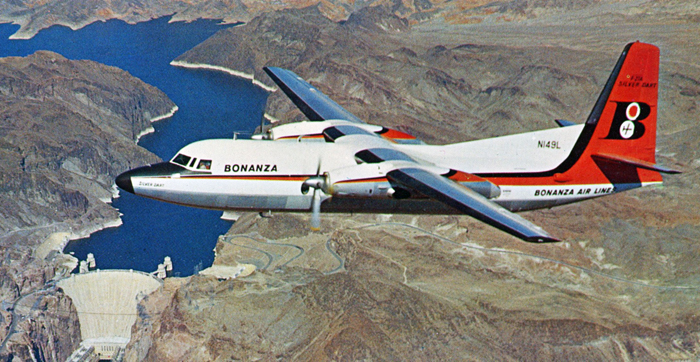 Bonanza
introduced the Fairchild F-27 "Silver Dart" across the Desert
Southwest in 1959, as this promotional photo shows N149L, a Fairchild
F-27A over Hoover Dam and Lake Mead (Postcard)
Bonanza
introduced the Fairchild F-27 "Silver Dart" across the Desert
Southwest in 1959, as this promotional photo shows N149L, a Fairchild
F-27A over Hoover Dam and Lake Mead (Postcard)
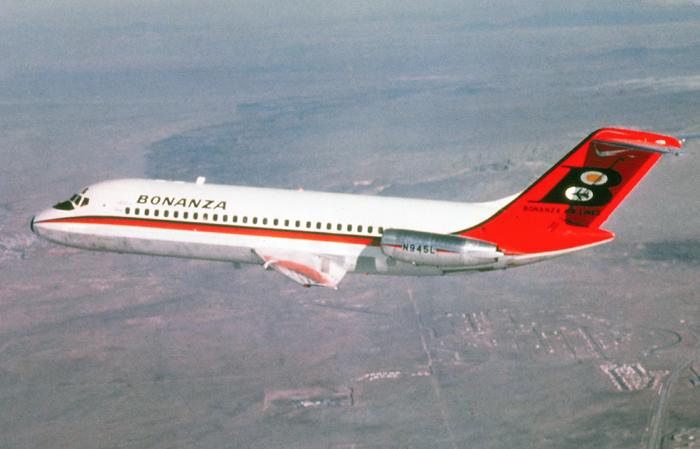 Bonanza
Air Lines received its first of three ordered Douglas DC-9 aircraft in
December 1965, with passenger flights starting on March, 1, 1965. Seen
on a pre-delivery test flight over the eastern Mojave Desert of
California in November 1965, is N945L, a Douglas DC-9-11, delivered a
few weeks later to Bonanza.
Bonanza
Air Lines received its first of three ordered Douglas DC-9 aircraft in
December 1965, with passenger flights starting on March, 1, 1965. Seen
on a pre-delivery test flight over the eastern Mojave Desert of
California in November 1965, is N945L, a Douglas DC-9-11, delivered a
few weeks later to Bonanza.
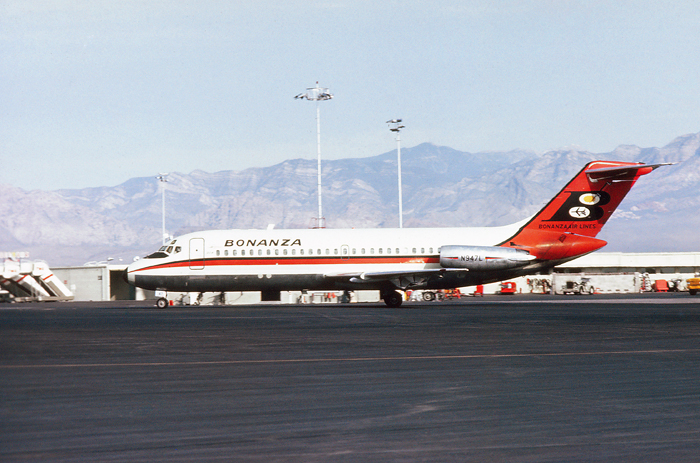 Bonanza Air Lines
introduced Douglas DC-9 "Fun Jet" service on trunk routes
including Las Vegas-Los Angeles, Las Vegas-Reno, Las Vegas-Phoenix, and
Phoenix-Slat Lake City in 1966. Seen pulling into the terminal area at
Las Vegas-McCarran International Airport in August 1967, is N947L,
a Douglas DC-9-11.
Bonanza Air Lines
introduced Douglas DC-9 "Fun Jet" service on trunk routes
including Las Vegas-Los Angeles, Las Vegas-Reno, Las Vegas-Phoenix, and
Phoenix-Slat Lake City in 1966. Seen pulling into the terminal area at
Las Vegas-McCarran International Airport in August 1967, is N947L,
a Douglas DC-9-11.
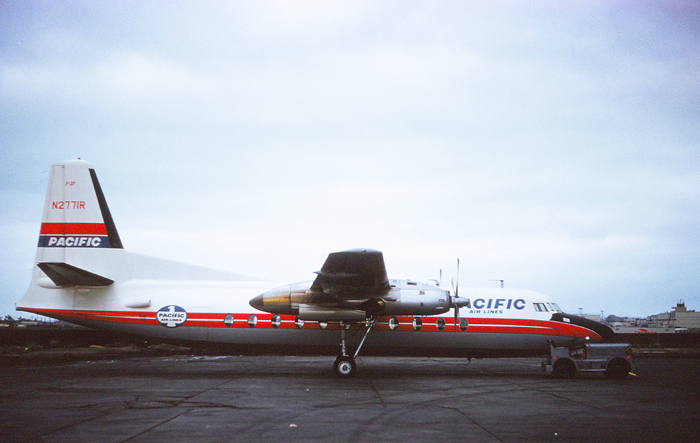 Labeled
the "Jet Hawk", Pacific Air Lines introduced the Fokker/Fairchild F-27
turboprop in 1959, on higher density routes from both San Francisco and
Los Angeles. Parked on the ramp at Los Angeles International Airport in
August 1959, is N2771R, a Fairchild F-27A, delivered new to Pacific on
June 11, 1959.
Labeled
the "Jet Hawk", Pacific Air Lines introduced the Fokker/Fairchild F-27
turboprop in 1959, on higher density routes from both San Francisco and
Los Angeles. Parked on the ramp at Los Angeles International Airport in
August 1959, is N2771R, a Fairchild F-27A, delivered new to Pacific on
June 11, 1959.
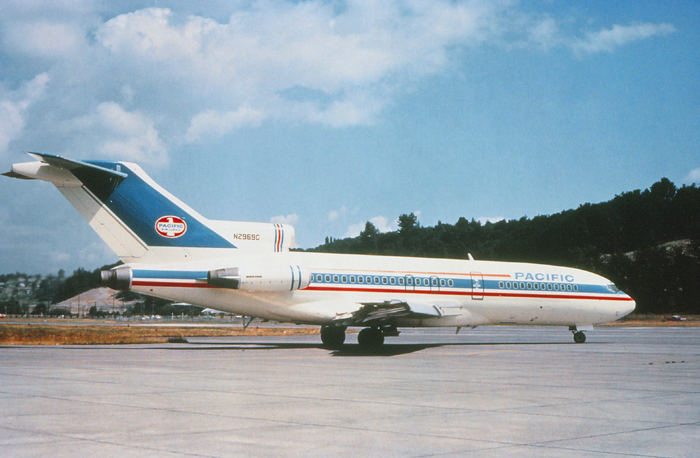 Looking sharp in
the Pacific Air Lines colors a month before delivery, N2969C, a Boeing
727-193, taxis out for a pre-delivery test flight at Seattle-Boeing
Field in June 1966.
Looking sharp in
the Pacific Air Lines colors a month before delivery, N2969C, a Boeing
727-193, taxis out for a pre-delivery test flight at Seattle-Boeing
Field in June 1966.
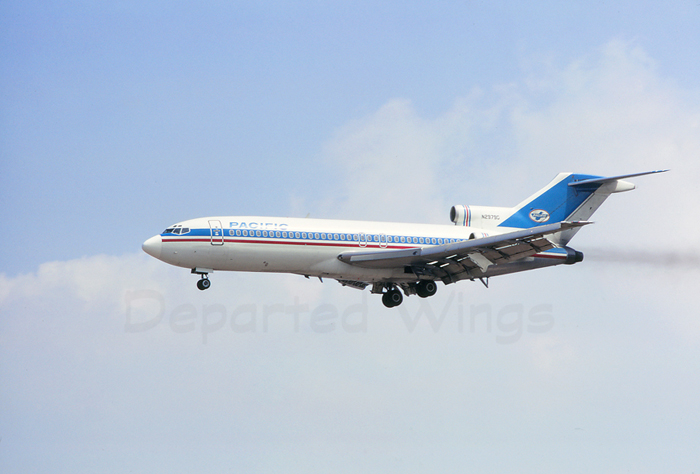 Pacific
Air Lines first pure-jet aircraft was the Boeing 727, of which three
were ordered for higher-capacity routes along the "California Corridor"
segments. On approach to Los Angeles International Airport in
April 1968, is N2979G, a Boeing 727-193, delivered new to Pacific Air
Lines in August 1966.
Pacific
Air Lines first pure-jet aircraft was the Boeing 727, of which three
were ordered for higher-capacity routes along the "California Corridor"
segments. On approach to Los Angeles International Airport in
April 1968, is N2979G, a Boeing 727-193, delivered new to Pacific Air
Lines in August 1966.
 For Pacific Air
Lines, the Fairchild F-27s brought "jet" service to many
smaller airports throughout its network, including this example N2777R,
a Fairchild F-27A being turned around at Fresno Air Terminal in
April 1968.
For Pacific Air
Lines, the Fairchild F-27s brought "jet" service to many
smaller airports throughout its network, including this example N2777R,
a Fairchild F-27A being turned around at Fresno Air Terminal in
April 1968.
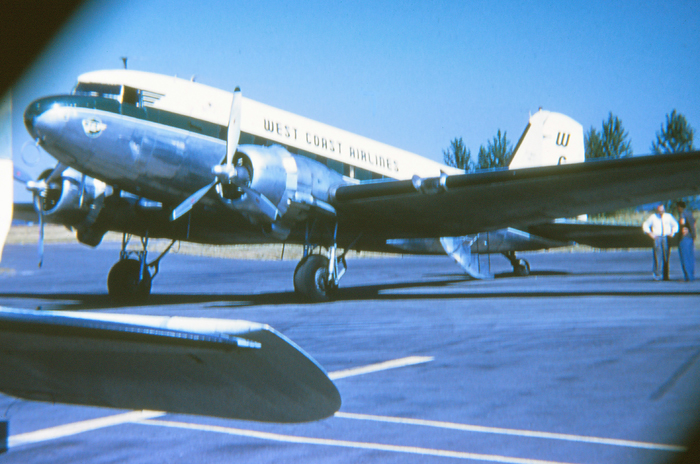 Pioneering local
service carrier West Coast Airlines, used a fleet of Douglas DC-3 "ScenicLiners,"
on its early services throughout the Pacific Northwest.
Pioneering local
service carrier West Coast Airlines, used a fleet of Douglas DC-3 "ScenicLiners,"
on its early services throughout the Pacific Northwest.
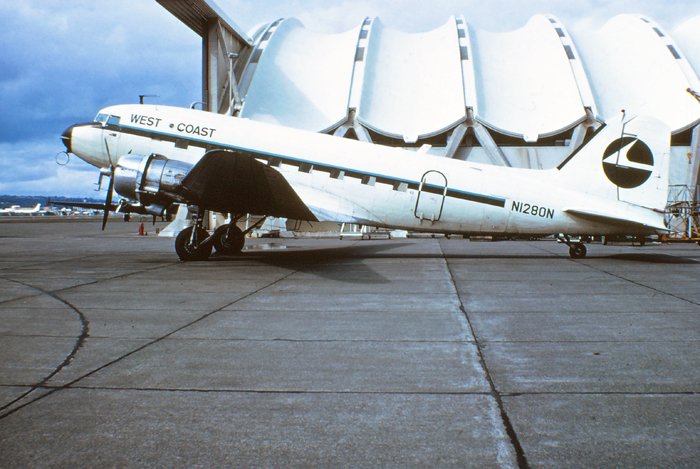 Wearing
the final colors of West Coast Airlines, even a few of the Douglas DC-3s
were repainted as the venerable planes were still be used on some of the
thinner routes to places such as Baker, Oregon and Rupert, Idaho. Parked
at Boeing Field in Seattle, Washington in 1967, is N1280N, a Douglas
C-47A.
Wearing
the final colors of West Coast Airlines, even a few of the Douglas DC-3s
were repainted as the venerable planes were still be used on some of the
thinner routes to places such as Baker, Oregon and Rupert, Idaho. Parked
at Boeing Field in Seattle, Washington in 1967, is N1280N, a Douglas
C-47A.
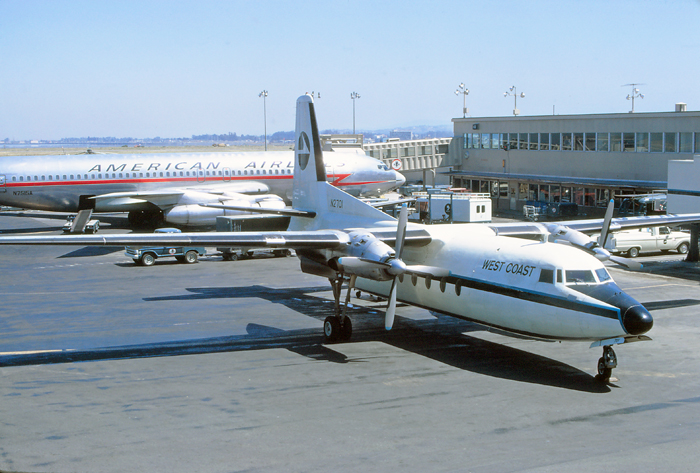 West
Coast Airlines had the distinction of being the world's first airline to
place the new "jet" powered Fokker/Fairchild F-27 in service during July
1958. The airline ordered five of the high winged turboprop to provide
more comfortable service over the rugged Pacific Northwest routes.
Parked on the ramp during an afternoon turn-around at San Francisco
International Airport in July 1968, is N2701, a Fairchild F-27, the
airlines first plane delivered on July 21, 1958.
West
Coast Airlines had the distinction of being the world's first airline to
place the new "jet" powered Fokker/Fairchild F-27 in service during July
1958. The airline ordered five of the high winged turboprop to provide
more comfortable service over the rugged Pacific Northwest routes.
Parked on the ramp during an afternoon turn-around at San Francisco
International Airport in July 1968, is N2701, a Fairchild F-27, the
airlines first plane delivered on July 21, 1958.
 A Douglas artist
impression of the new West Coast Douglas DC-9 over the picturesque
Pacific Northwest.
A Douglas artist
impression of the new West Coast Douglas DC-9 over the picturesque
Pacific Northwest.
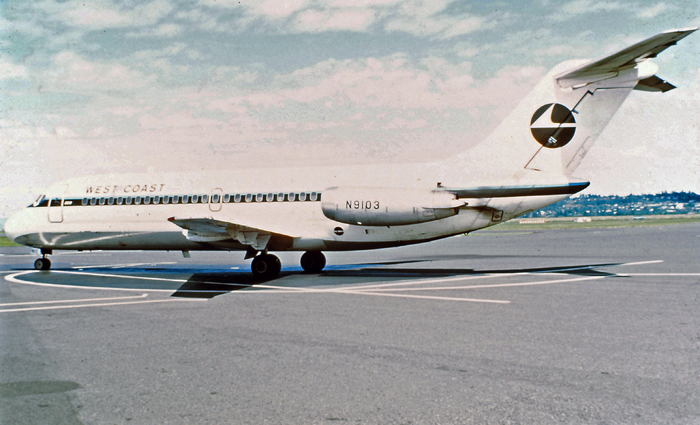 Eager
to join the jet "club" amongst the local service airlines, West
Coast Airlines received its first all-jet aircraft, the Douglas DC-9 in
September 1966. Parked on the ramp at Portland International Airport in
October 1967, is N9103, a Douglas DC-9-14, delivered new to West Coast
Airlines in December 1966.
Eager
to join the jet "club" amongst the local service airlines, West
Coast Airlines received its first all-jet aircraft, the Douglas DC-9 in
September 1966. Parked on the ramp at Portland International Airport in
October 1967, is N9103, a Douglas DC-9-14, delivered new to West Coast
Airlines in December 1966.
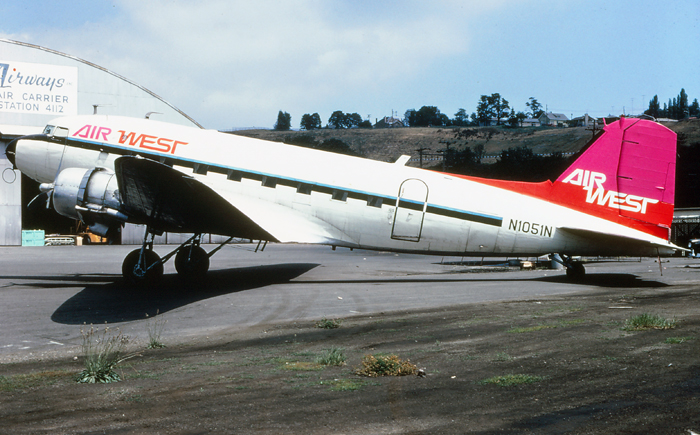 By
the late 1960s, the Douglas DC-3 was considered obsolete to even to the
local carriers, however one of the DC-3s from West Coast Airlines
received the new AirWest colors before finally being retired in 1969.
Parked at Boeing Field in Seattle, Washington wearing its new owners
"hybrid" colors in 1968, is N1051N, a Douglas C-47.
By
the late 1960s, the Douglas DC-3 was considered obsolete to even to the
local carriers, however one of the DC-3s from West Coast Airlines
received the new AirWest colors before finally being retired in 1969.
Parked at Boeing Field in Seattle, Washington wearing its new owners
"hybrid" colors in 1968, is N1051N, a Douglas C-47.
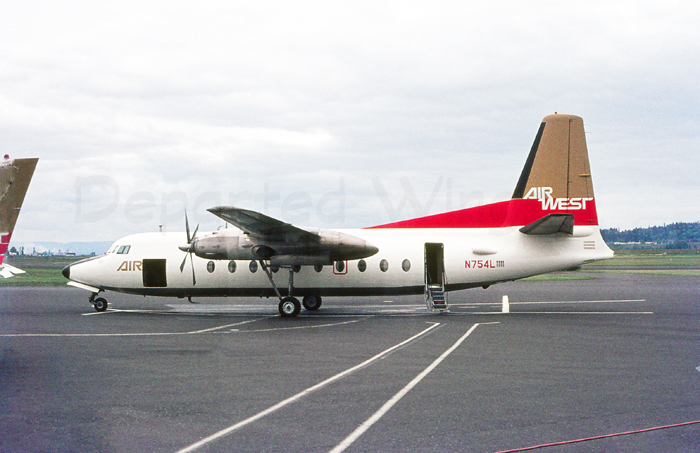 Portland was one of
the larger "hubs" of the new Airwest with numerous departures
daily across the Pacific Northwest. The Fokker F-27s were providing
regional services from Portland to destinations such as Crescent City,
Astoria, Bend, Yakima, and Pasco. Parked on the ramp and awaiting
passengers at Portland International Airport in April 1968, is N754L, a
Fairchild F-27A.
Portland was one of
the larger "hubs" of the new Airwest with numerous departures
daily across the Pacific Northwest. The Fokker F-27s were providing
regional services from Portland to destinations such as Crescent City,
Astoria, Bend, Yakima, and Pasco. Parked on the ramp and awaiting
passengers at Portland International Airport in April 1968, is N754L, a
Fairchild F-27A.
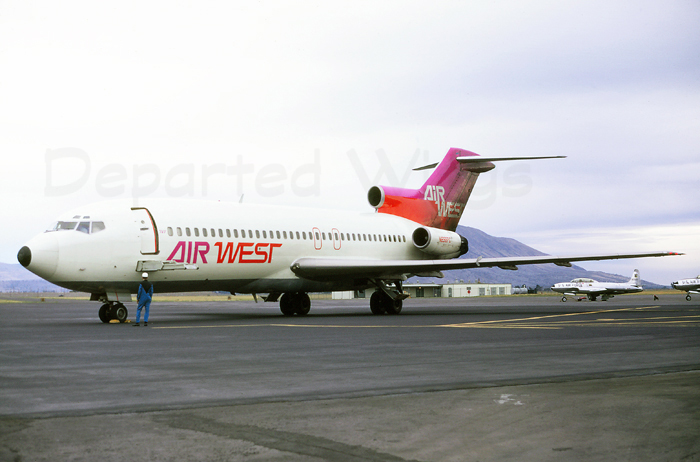 Airwest's Boeing
727s had integral air stairs to help with passenger loading at smaller
stations, such as this example, N898PC, a Boeing 727-193, having just
arrived at Klamath Falls Municipal Airport in September 1968, ad
deploying the forward airstairs.
Airwest's Boeing
727s had integral air stairs to help with passenger loading at smaller
stations, such as this example, N898PC, a Boeing 727-193, having just
arrived at Klamath Falls Municipal Airport in September 1968, ad
deploying the forward airstairs.
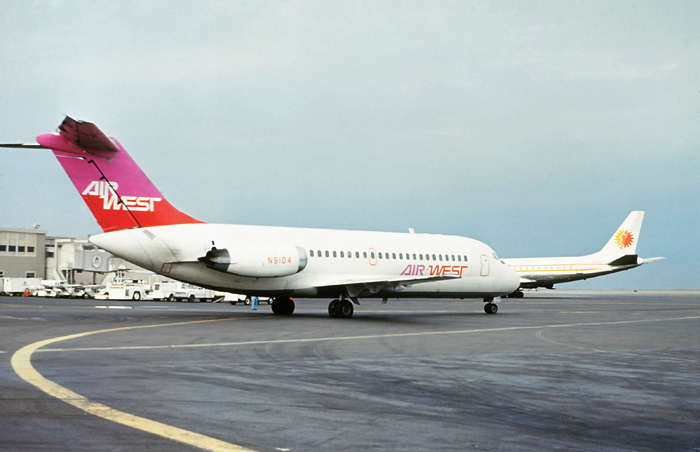 The last Douglas DC-9 delivered to West Coast Airlines in April 1968,
N9104, a Douglas DC-9-15, wearing its new two-tone color scheme taxies
away from the gate at San Francisco International Airport in May 1969.
The last Douglas DC-9 delivered to West Coast Airlines in April 1968,
N9104, a Douglas DC-9-15, wearing its new two-tone color scheme taxies
away from the gate at San Francisco International Airport in May 1969.
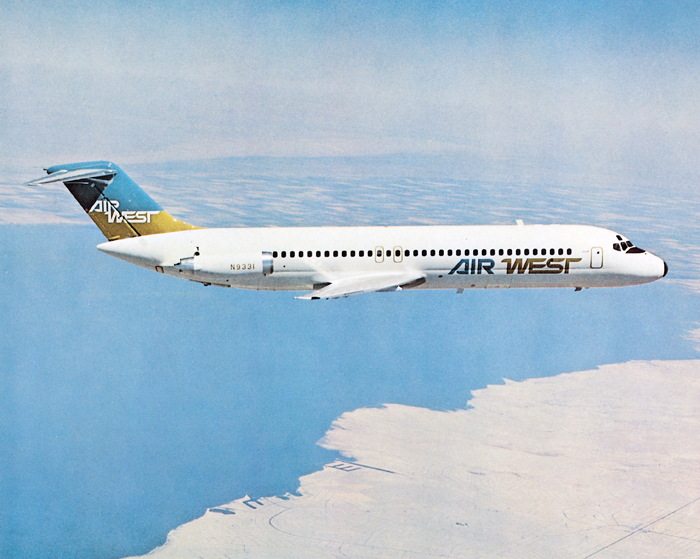 Originally part
of the West Coast Airlines order, N9331, a Douglas DC-9-31 was taken up
by AirWest instead and is seen on a pre-delivery test flight over the
Salton Sea in May 1968.
Originally part
of the West Coast Airlines order, N9331, a Douglas DC-9-31 was taken up
by AirWest instead and is seen on a pre-delivery test flight over the
Salton Sea in May 1968.
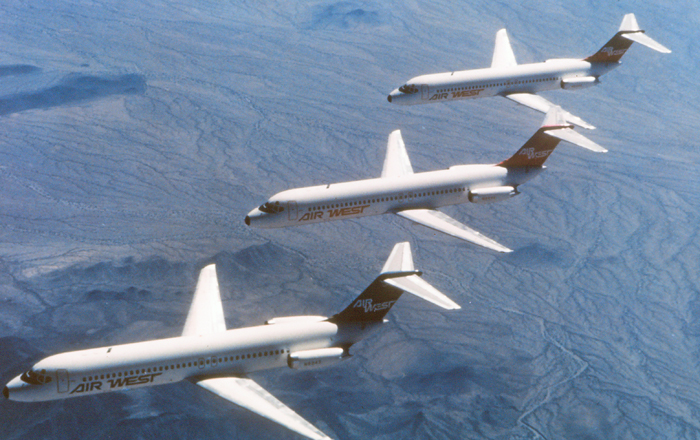 A
stunning display of three new AirWest Douglas DC-9s (N9343, N9344 and
N9345) on a pre-delivery formation flight over the desert of eastern
California in June 1969.
A
stunning display of three new AirWest Douglas DC-9s (N9343, N9344 and
N9345) on a pre-delivery formation flight over the desert of eastern
California in June 1969.
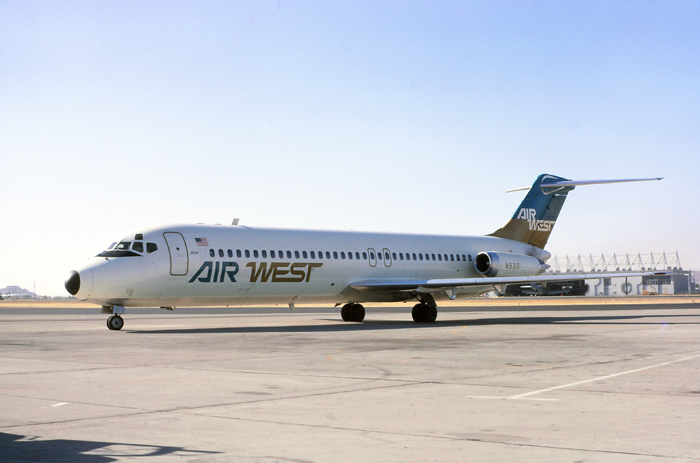 Seen taxiing away from the
passenger terminal at Tucson International Airport on a bright morning in
June 1969, is N9331, a
Douglas DC-9-31, delivered new to the airline on June 4, 1968.
Seen taxiing away from the
passenger terminal at Tucson International Airport on a bright morning in
June 1969, is N9331, a
Douglas DC-9-31, delivered new to the airline on June 4, 1968.
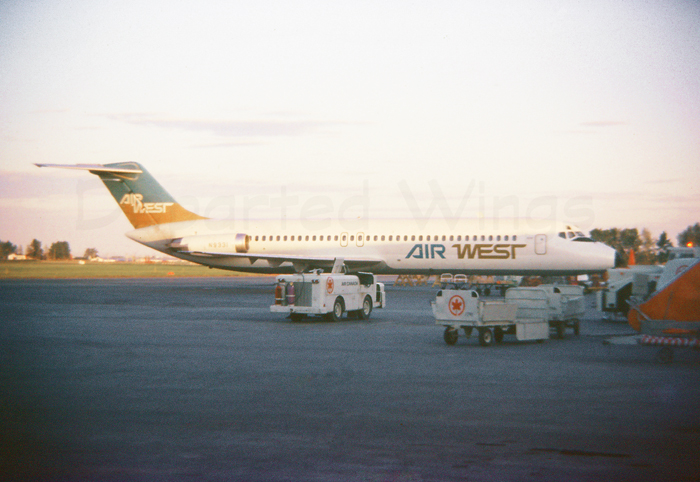 During 1960, West
Coast Airlines started service to Calgary, Canada from Spokane with
Fairchild F-27 aircraft. This would be the only international service
flown by the airline and would continue to be served by AirWest after
the merger. Parked at the terminal at Calgary International Airport in
June 1969, is N9331, a Douglas DC-9-31.
During 1960, West
Coast Airlines started service to Calgary, Canada from Spokane with
Fairchild F-27 aircraft. This would be the only international service
flown by the airline and would continue to be served by AirWest after
the merger. Parked at the terminal at Calgary International Airport in
June 1969, is N9331, a Douglas DC-9-31.
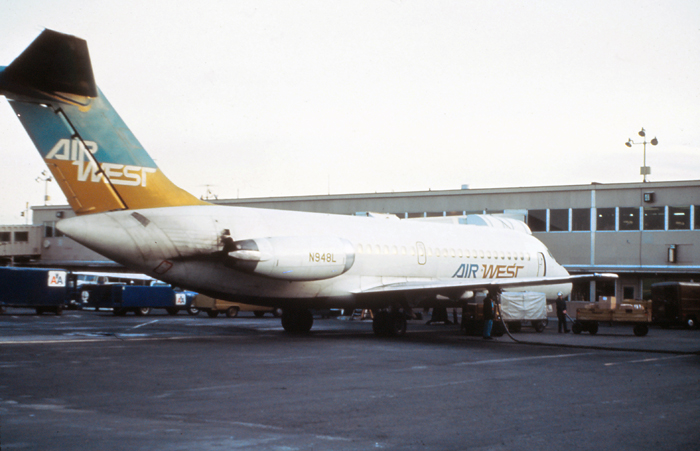 Initially
operated by Bonanza Air Lines and parked at the gate at San Francisco
International Airport in 1969, is N948L, a Douglas DC-9-14, delivered to
Bonanza in June 1967.
Initially
operated by Bonanza Air Lines and parked at the gate at San Francisco
International Airport in 1969, is N948L, a Douglas DC-9-14, delivered to
Bonanza in June 1967.
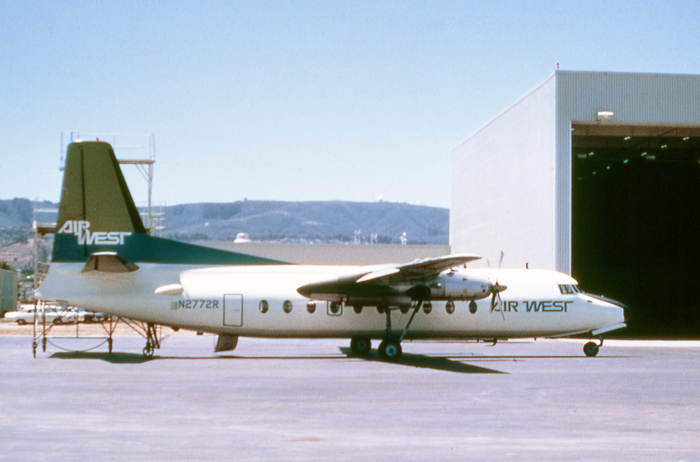 With
the formation of AirWest, the new airline to ownership of thirty-five
Fairchild F-27 airplanes which had been operated by all three of the
previous local carriers. Parked at the AirWest maintenance ramp at San
Francisco International Airport in 1969, is N2772R, a Fairchild F-27A,
originally delivered to pacific Air Lines in April 1959.
With
the formation of AirWest, the new airline to ownership of thirty-five
Fairchild F-27 airplanes which had been operated by all three of the
previous local carriers. Parked at the AirWest maintenance ramp at San
Francisco International Airport in 1969, is N2772R, a Fairchild F-27A,
originally delivered to pacific Air Lines in April 1959.
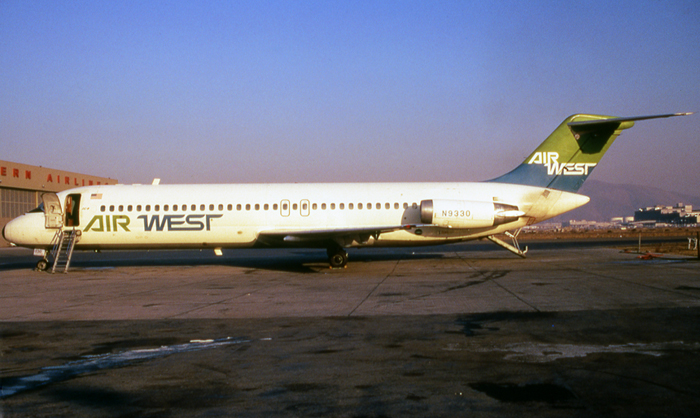 One of the
"stretch" Douglas DC-9s undergoing maintenance at San Francisco
International Airport in 1969, is N9330, a Douglas DC-9-31, the fifth
DC-9 ordered by West Coast Airlines but not taken up and delivered to AirWest on May 27, 1968.
One of the
"stretch" Douglas DC-9s undergoing maintenance at San Francisco
International Airport in 1969, is N9330, a Douglas DC-9-31, the fifth
DC-9 ordered by West Coast Airlines but not taken up and delivered to AirWest on May 27, 1968.
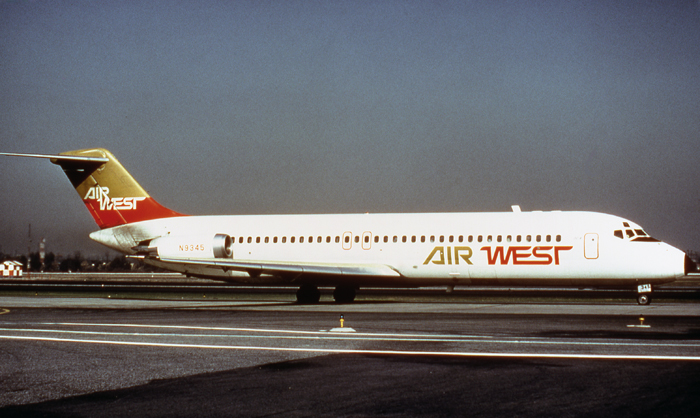 With a fleet of
twenty-six Douglas DC-9 aircraft, the twin-engined plane made up the
bulk of the AirWest fleet. Taxiing outbound to Runway 24 at Los Angeles
International Airport in early 1970, is N9345, a Douglas DC-9-31,
originally delivered new to AirWest in June 1969. Tragically this
aircraft was involved in a mid-air collision with a military Douglas F-4 phantom
jet over the San Gabriel Mountains in eastern Los Angeles and crashed on
July 1, 1970, while on a flight from Los Angeles to Salt Lake City.
With a fleet of
twenty-six Douglas DC-9 aircraft, the twin-engined plane made up the
bulk of the AirWest fleet. Taxiing outbound to Runway 24 at Los Angeles
International Airport in early 1970, is N9345, a Douglas DC-9-31,
originally delivered new to AirWest in June 1969. Tragically this
aircraft was involved in a mid-air collision with a military Douglas F-4 phantom
jet over the San Gabriel Mountains in eastern Los Angeles and crashed on
July 1, 1970, while on a flight from Los Angeles to Salt Lake City.
 After the merger
AirWest acquired three Boeing 727s from Pacific Air Lines. The planes
capacity was typically too large for the AirWest system and were
subsequently leased out to Braniff Airways before being returned to AirWest in March 1970. Parked at the terminal at Las Vegas McCarran
Airport in April 1970, is N2969G, a Boeing 727-193, delivered new to
Pacific Air Lines in July 1966. This aircraft crashed in Juneau, Alaska,
while being operated by Alaska Airlines on September 4, 1971.
After the merger
AirWest acquired three Boeing 727s from Pacific Air Lines. The planes
capacity was typically too large for the AirWest system and were
subsequently leased out to Braniff Airways before being returned to AirWest in March 1970. Parked at the terminal at Las Vegas McCarran
Airport in April 1970, is N2969G, a Boeing 727-193, delivered new to
Pacific Air Lines in July 1966. This aircraft crashed in Juneau, Alaska,
while being operated by Alaska Airlines on September 4, 1971.